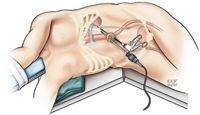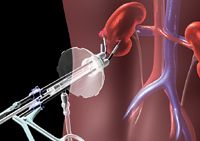Article
Laparo-endoscopic single-site surgery, natural orifice transluminal endoscopic surgery procedures nearing clinical feasibility
Cleveland-Laparo-endoscopic single-site surgery (LESS) and natural orifice transluminal endoscopic surgery (NOTES) for urologic procedures are moving "from talk to reality," according to Inderbir S. Gill, MD, professor, chairman, and executive director, Institute of Urology, Keck School of Medicine at the University of Southern California, Los Angeles.


Patient satisfaction with LESS is high, Dr. Gill reports. In his series of nearly 20 LESS live-donor nephrectomies, the technique was associated with less analgesia, more rapid recovery and return to work, and greater scar satisfaction in comparison with conventional laparoscopic nephrectomy.
In contrast, the current status of pure NOTES is more difficult to assess, Dr. Gill said. Panelists at the Innovation Summit estimated that 300 procedures in human subjects have been performed worldwide, virtually all in the realm of general surgery.
"Clearly, this is very encouraging. At the same time, it is important to note that the overwhelming majority of them have been performed in a NOTES-assisted format using one or more abdominal trocars in addition to the natural orifice," Dr. Gill said.
Dr. Gill and his former team at Cleveland Clinic have performed five pure transvaginal nephrectomies in the porcine model. In addition, Dr. Gill has attempted three NOTES–assisted nephrectomy procedures in humans under institutional approval. In each human case, the procedure had to be converted to a transabdominal laparoscopy due to lack of technical maneuverability or inadequate retraction or visualization.
Urologists pushing the envelope with these techniques agree that technology is the limiting factor. Surgeons currently are adapting technologies and instruments designed primarily for multi-port standard laparoscopic procedures for LESS and NOTES, which limits the type of procedures that can be undertaken safely.
"Success is all a matter of visualization and tissue manipulation," Dr. Gill said. "Intra-abdominal operative triangulation is essential. This will be better delivered by purpose-designed instruments and robotic systems engineered specifically for single-port LESS surgery.
"Applications for NOTES are likely to be limited to technically simpler procedures," he said. "For more substantive, heavy-duty ablation and reconstructive surgery, LESS will carry the day."
Many urologists are cautious about adopting LESS and NOTES before substantial clinical and economic benefits of using these techniques have been documented. Others, like Dr. Gill, believe that cutting-edge innovation is the necessary first step in gathering the desired data to compare these techniques with standard laparoscopy.
Dr. Gill discloses that he is affiliated with Hansen Medical.





